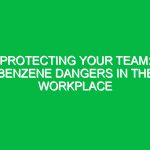Introduction
In the ever-evolving landscape of health, safety, and environment (HSE) standards, the term “Personal Protective Equipment” or PPE has garnered considerable attention. PPE encompasses a range of protective gear designed to safeguard workers from various workplace hazards, which can include physical, chemical, biological, and ergonomic risks. Understanding what PPE is and its critical role in HSE practices is essential for fostering a safe working environment. This article delves into the definition of PPE, its relevance in the HSE domain, and the standards that govern its use.
Defining PPE in the HSE Context
Personal Protective Equipment (PPE) is defined as equipment worn by individuals to minimize exposure to hazards that could cause serious injuries or illnesses in the workplace. The Occupational Safety and Health Administration (OSHA) outlines PPE as “specialized clothing or equipment worn by an employee for protection against infectious materials.” The scope of PPE extends across various industries, including construction, healthcare, manufacturing, and many others.
The effectiveness of PPE is contingent upon proper selection, usage, and maintenance. When used correctly, PPE serves as a last line of defense against hazards, complementing other safety measures such as engineering controls and administrative procedures.
The Importance of PPE in HSE
Why is PPE so vital in the landscape of HSE? The answer lies in the multitude of risks present in various working environments. For instance, workers in construction sites may face falling objects, while healthcare professionals might encounter exposure to infectious materials. In both scenarios, PPE becomes indispensable.
Moreover, the implementation of PPE can lead to a substantial reduction in workplace injuries and illnesses. According to the National Safety Council, proper use of PPE helps prevent approximately 70% of workplace injuries. This not only protects individual employees but also contributes to organizational efficiency and morale.
Key Components of PPE
To effectively define PPE, it’s important to explore its essential components and types. Each type of PPE addresses specific hazards:
- Head Protection: Hard hats and helmets protect against falling objects and head injuries.
- Eye and Face Protection: Safety goggles, face shields, and glasses shield against chemical splashes, flying debris, and radiation.
- Respiratory Protection: Masks and respirators filter harmful airborne particles and gases, ensuring clean air for workers in hazardous environments.
- Hearing Protection: Earplugs and earmuffs reduce noise exposure, preventing hearing loss in loud environments.
- Hand Protection: Gloves made from various materials protect against cuts, chemical exposure, and thermal hazards.
- Body Protection: Coveralls, aprons, and vests shield against chemical spills, heat, and other physical hazards.
- Foot Protection: Steel-toed boots and non-slip footwear protect feet from falling objects and slippery surfaces.
Each component plays a crucial role in ensuring safety, and it’s essential for employers to assess the specific risks associated with their industry to determine the appropriate PPE for their workforce.
Assessing Risks and Selecting the Right PPE
Selecting the right PPE begins with a thorough risk assessment. A comprehensive evaluation of the workplace should identify potential hazards and determine the types of PPE necessary for protection. This process involves:
- Identifying Hazards: Conduct a walkthrough of the workplace to identify potential hazards, including chemical exposures, sharp objects, and noise levels.
- Evaluating Risks: Assess the likelihood and severity of injuries or illnesses that could result from identified hazards.
- Determining PPE Requirements: Based on the assessment, determine the types of PPE needed to mitigate risks effectively.
For instance, a construction site might require hard hats and safety glasses, while a laboratory would necessitate gloves, goggles, and lab coats. It’s essential to involve employees in this process, as they can provide insights into potential hazards based on their firsthand experiences.
Best Practices for PPE Usage
Once PPE has been selected, its effectiveness hinges on proper usage. Here are some best practices to ensure that employees are adequately protected:
- Training and Education: Provide comprehensive training on the correct use, maintenance, and limitations of PPE.
- Regular Inspections: Implement routine checks of PPE to identify wear and tear, replacing any damaged equipment immediately.
- Encouragement of Usage: Foster a culture where employees feel comfortable wearing PPE and understand its importance in ensuring their safety.
- Clear Signage: Use signs and labels to remind employees of the required PPE for specific tasks.
These practices can significantly enhance the overall safety culture of an organization, reducing the likelihood of accidents and injuries.
Challenges in PPE Compliance
While PPE is essential, compliance can often be a challenge. Employees may resist wearing PPE due to discomfort or perceived inconvenience. For example, a construction worker may find a respirator cumbersome, leading to its improper use.
To combat these challenges, employers should focus on:
- Choosing Comfortable Gear: Invest in high-quality PPE that balances protection with comfort to encourage regular use.
- Involvement in Selection: Involve employees in the selection process to ensure the PPE meets their needs and preferences.
- Regular Feedback: Create a feedback loop where employees can voice concerns or suggestions regarding PPE use.
By addressing these challenges, organizations can enhance compliance and ultimately improve workplace safety.
Regulations and Standards Governing PPE
Understanding the regulations around PPE is critical for compliance and safety. Various organizations, such as OSHA and the National Institute for Occupational Safety and Health (NIOSH), set standards that govern the use of PPE.
- OSHA Standards: OSHA provides clear guidelines on the types of PPE required for different industries and tasks, mandating that employers conduct hazard assessments and ensure the correct PPE is provided.
- NIOSH Certification: NIOSH certifies respiratory protective devices, ensuring that they meet safety and performance standards.
- ANSI Standards: The American National Standards Institute (ANSI) sets standards for various types of PPE, ensuring they provide adequate protection for their intended use.
Compliance with these regulations not only enhances safety but also protects organizations from potential legal liabilities and penalties.
Real-Life Applications of PPE in Various Industries
To illustrate the importance of PPE, let’s explore some real-life applications across different sectors.
Construction Industry
In the construction industry, the use of PPE is not just a guideline; it’s a necessity. Hard hats, safety goggles, and steel-toed boots are standard in protecting workers from falling debris and other potential hazards. For instance, a construction site foreman once shared how the proper use of PPE saved a worker’s life when a heavy beam fell. The worker, equipped with a hard hat and safety gear, sustained only minor injuries.
Healthcare Sector
In healthcare settings, the importance of PPE cannot be overstated. During the COVID-19 pandemic, healthcare workers relied heavily on PPE to protect themselves from the virus. Masks, face shields, and gowns became essential to ensure the safety of both patients and staff. A nurse recounted how a well-fitted N95 respirator and face shield prevented her from contracting the virus while caring for infected patients. This example highlights the critical role of PPE in safeguarding health professionals.
Conclusion
In summary, Personal Protective Equipment (PPE) is a fundamental component of health, safety, and environmental (HSE) practices. By defining PPE and understanding its importance, organizations can create safer workplaces, reduce the risk of injuries, and foster a culture of safety.
Through thorough risk assessments, proper training, and compliance with regulations, businesses can ensure that their workforce is protected effectively. As we navigate the challenges of workplace safety, it is imperative to prioritize the use of PPE as a vital aspect of HSE standards. By doing so, organizations not only safeguard their employees but also enhance productivity and morale, ultimately contributing to long-term success and sustainability.


